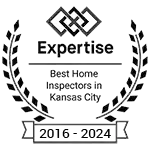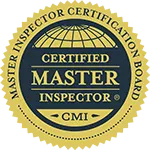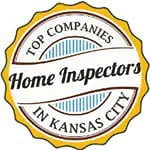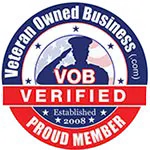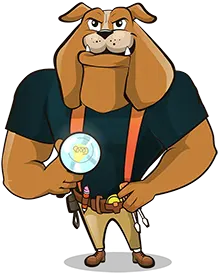Key Takeaways:
- What are the Various Types of AC Systems? (3 min): Central AC, heat pumps, mini splits, and swamp coolers
- What Maintenance Each AC System Needs 4 min): From changing filters to cleaning coils
- How Long Each AC System Should Last (2 min): The average life for each type of AC system.
- What to Do When Something Goes Wrong with Your AC System (3 min): A quick guide
- How Much AC Systems Cost (2 min): A breakdown of cooling system costs for Kansas City homeowners.
- What are the Various Types of Heating Systems? (3 min): Furnace, heat pumps, boilers, and hybrid systems
- What Maintenance Each Heating System Needs (4 min): From cleaning burners to flushing the system.
- How Long Each Heating System Should Last (2 min): The average life for each type of heating system
- What to Do When Something Goes Wrong with Your Heating System (3 min): Another quick guide
- How Much Heating Systems Cost (2 min): A breakdown of heating system costs
- Seasonal HVAC System Tips (4 min): Keep your HVAC system running smoothly and efficiently year-round.
- Mythbusters: Common Myths About HVAC Systems (4 min.): These myths can damage your system
- Tips for Choosing the Right HVAC System (3 min.): Tips to make the best choice
Estimated Reading Time for the Entire Post: 60 minutes
There are 5 major areas in every home no matter how big or how old it is:
1. Foundation
2. Plumbing System
3. Roof
4. Electrical System
5. HVAC System
These are what you call “the bones”, the basis for our Major-Items Inspection, and the focus of our discussion at the end of every inspection.
When it comes to feeling comfortable in your home, we’re talking about the HVAC system—the system that keeps you warm in the winter and cool in the summer.
In Kansas City, that means air conditioners, heat pumps, furnaces, and sometimes even boilers.
Let’s talk about the basics: what these are, how they work, where you’ll find them, and how long they’ll last.
Here’s where you can see how we inspect the HVAC system.
Air Conditioning Systems
Introduction to AC Systems
Air conditioning (AC) systems do more than just cool your home. They also remove moisture from the air, making your living space more comfortable. This process involves drawing warm air from your home, passing it over cold coils to cool it down, and then releasing it back into the room. As the air cools, moisture condenses on the coils and drains away, reducing humidity. By lowering both temperature and humidity, AC systems prevent mold growth and improve air quality. This dual function is essential for maintaining a healthy indoor environment, especially during hot and humid summer months.
What are the Various Types of AC Systems?
There are several types of air conditioning systems to choose from, each with its own benefits and drawbacks.
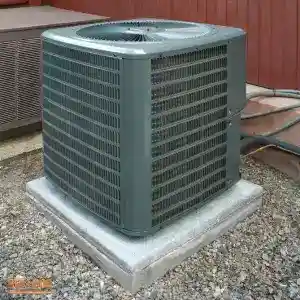
Central Air Conditioning: This HVAC system uses a network of ducts to distribute cool air throughout the house. According to the U.S. Department of Energy, central AC systems are the most common type of air conditioning used in residential buildings. These systems are efficient for cooling large areas and can be controlled via a central thermostat. They typically have SEER (Seasonal Energy Efficiency Ratio) ratings between 13 and 21, with higher numbers indicating better energy efficiency.
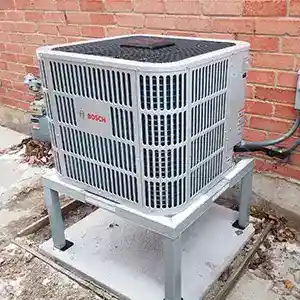
Air-to-Air Heat Pumps: This HVAC system transfers heat between your house and the outside air, providing both heating and cooling. They are most effective in moderate climates. The Environmental Protection Agency notes that heat pumps can be up to 50% more efficient than traditional heating and cooling systems. They can look exactly like an AC condenser, except they contain a reversing valve. They usually have SEER ratings of 14 to 20.
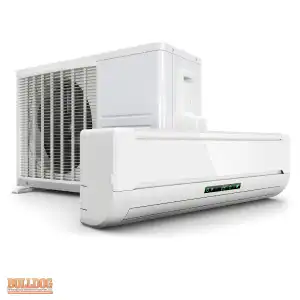
Ductless, Mini-Split Air Conditioners: Ideal for homes without existing ductwork, a ductless mini-split HVAC system offers zoned cooling, meaning you can cool specific areas of your home independently. The Energy Star program highlights their high energy efficiency and flexibility, making them an excellent option for older homes or room additions. They typically have SEER ratings ranging from 16 to 23 and can save up to 30% on cooling costs compared to traditional systems.
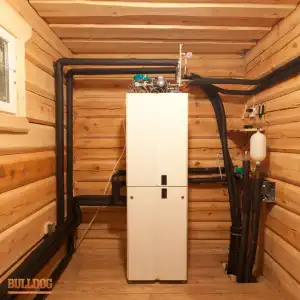
Ground Source (Geothermal) Heat Pumps: This HVAC system goes into the ground and uses the earth’s consistent temperature to heat and cool your home. They can be upwards to 100% efficient and according to the U.S. Department of Energy, can reduce energy use by 30-60%. they have a higher upfront cost, but offer significant long-term savings and typically have a lifespan of 25 years for the indoor components and 50+ years for the ground loop. You not will see an outside condenser unit with this system.
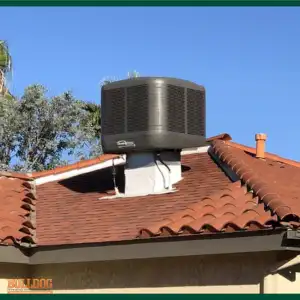
Swamp Coolers (Evaporative Coolers): The last HVAC system uses evaporation to cool the air and is best suited for dry climates. They are more energy-efficient than traditional AC systems but are less effective in humid areas. Data from the National Renewable Energy Laboratory shows that swamp coolers can use up to 75% less electricity than central air conditioners in the right climates. They are also more affordable, with lower installation and operating costs.
Where You’ll Find the Various Types of AC Systems
Different AC systems are suited to various types of buildings and regions. Here’s a breakdown of where you might find each type:
Residential vs. Commercial Buildings: Central air conditioning is common in suburban homes and large commercial buildings due to its ability to efficiently cool large spaces through a network of ducts. In contrast, ductless mini-split systems are often found in smaller homes, apartments, and commercial spaces without existing ductwork. Heat pumps, particularly air-to-air models, are popular in both residential and commercial settings in milder climates. Swamp coolers are typically used in residential homes in dry, arid regions but can also be found in smaller commercial buildings.
Regional Preferences
Central AC: Most suburban homes across the U.S. have central air conditioning systems. This is especially true in regions with hot summers, such as the Southern states, where consistent, powerful cooling is needed. According to the U.S. Census Bureau, central AC is installed in over 87% of newly built single-family homes, highlighting its dominance in the residential market.
Ductless Mini-Split: These systems are gaining popularity in older homes without ductwork and in regions where adding ducts is not feasible. The Northwest Energy Efficiency Alliance reports a significant increase in mini-split installations in the Pacific Northwest due to their efficiency and flexibility. They are also popular in urban areas where space is limited.
Heat Pumps: Preferred in milder climates for both heating and cooling, heat pumps are especially common in the Southeast and Northwest. The U.S. Energy Information Administration notes that over 40% of homes in the South use heat pumps. Their ability to provide year-round climate control makes them a versatile option for regions with moderate temperature swings.
Swamp Coolers: Common in dry, arid regions like the Southwest, swamp coolers are popular in states such as Arizona and New Mexico. The National Renewable Energy Laboratory indicates that up to 25% of homes in these areas use evaporative cooling systems. Their low energy consumption and ability to add moisture to the dry air make them ideal for these environments.
When Different Types of AC Systems Were Used Through Time
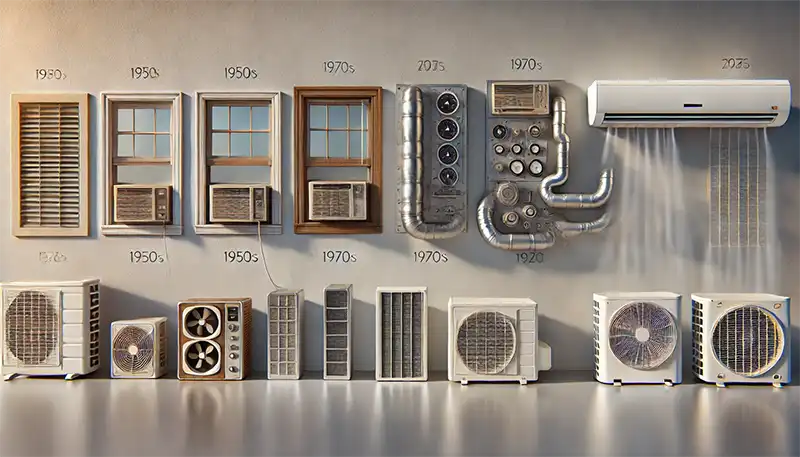
Air conditioning systems have evolved significantly over the years, with each era introducing new technologies and improvements.
- Early 1900s: The introduction of mechanical refrigeration and early air conditioning systems marked the beginning of modern cooling. In 1902, Willis Carrier invented the first modern air conditioner to control humidity in a printing plant. This invention laid the groundwork for future developments in air conditioning technology.
- 1920s: Central air conditioning systems started to be installed in public buildings and the homes of the wealthy. The growth of skyscrapers and movie theaters drove the demand for air conditioning, making it more visible and desirable. For instance, the Rivoli Theater in New York was one of the first public spaces to use air conditioning, enhancing the movie-going experience and boosting attendance.
- 1950s-1960s: The post-World War II economic boom saw central air conditioning becoming more common in residential homes. According to the U.S. Census Bureau, the number of homes with central AC increased dramatically during this period, making it a standard feature in many new houses. The widespread availability of affordable window units also contributed to the growing adoption of AC in middle-class homes.
- 1970s: The energy crisis led to the development of more energy-efficient models. The introduction of energy-efficient air conditioners with improved SEER ratings aimed to reduce energy consumption and costs. Additionally, the U.S. government started to regulate energy efficiency standards for AC units, which spurred innovation in the industry.
- 1990s-Present: Ductless mini-split systems gained popularity due to their flexibility and efficiency. Advancements in heat pump technology also made these systems more viable for both heating and cooling. The Energy Star program began certifying high-efficiency units, promoting energy conservation. Additionally, the development of environmentally friendly refrigerants addressed the growing concerns about ozone depletion. The rise of smart thermostats and home automation has further revolutionized the industry, allowing for precise temperature control and increased energy savings.
Key Milestones:
- 1902: Willis Carrier invents the modern air conditioner.
- 1931: Introduction of the window air conditioner, making cooling accessible to a broader audience.
- 1950s-1960s: Rapid expansion of central air conditioning in residential homes.
- 1970s: Energy-efficient models emerged, and heat pumps were introduced as dual-function systems for heating and cooling.
- 1990s: Development of energy-efficient and environmentally friendly refrigerants.
- 2000s: Use of smart thermostats and home automation increased, enhancing the control and efficiency of AC systems.
What Maintenance Each AC System Needs
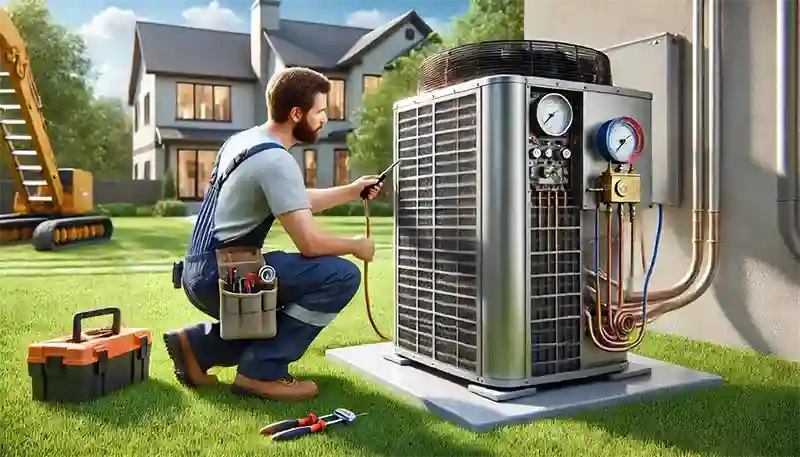
Maintaining your AC system is crucial for ensuring its efficiency and longevity. Different types of AC systems have varying maintenance needs, but some tasks are universal.
- Basic Maintenance Tasks: Regular maintenance tasks are essential for all AC systems to function optimally.
- Changing Filters: Replace or clean filters every 1-3 months to ensure proper airflow and efficiency. The Department of Energy states that clean filters can lower your air conditioner’s energy consumption by 5-15%.
- Cleaning Coils: Ensure the evaporator and condenser coils are clean to maintain efficiency. Dirty coils reduce the system’s ability to cool your home and cause the system to run longer, increasing energy costs and reducing the lifespan of the unit.
- Checking Thermostats: Verify thermostat settings and functionality to ensure your system is running when you need it and not wasting energy.
- Inspecting Ductwork: Look for leaks or blockages in ducted systems. According to Energy Star, leaky ducts can reduce a system’s efficiency by up to 20%.
- Specific Needs for Each Type:
- Central AC: Central air conditioning systems require regular duct cleaning, refrigerant level checks, and blower fan inspections. The American Society of Heating, Refrigerating, and Air-Conditioning Engineers recommends annual professional inspections to maintain system performance. It’s also crucial to check the condensate drain for clogs.
- Ductless Mini-Split: These systems need indoor unit filters cleaned monthly and outdoor unit coils checked regularly. They also benefit from professional inspections to ensure optimal performance and longevity. Clearing any debris around the outdoor unit is also essential.
- Heat Pumps: Heat pumps require both indoor and outdoor units to be inspected and cleaned. Checking refrigerant levels and ensuring the proper function of the reversing valve are critical. The Energy Information Administration highlights that regular maintenance can improve efficiency by 10-25%. In colder climates, defrosting the outdoor unit and clearing snow and ice is important.
- Swamp Coolers: Regular cleaning and replacing of cooling pads, checking water levels, and ensuring proper drainage are vital for swamp coolers. They also need to be shut down and cleaned before winter to prevent damage from freezing temperatures. In addition, checking the water distribution system and ensuring it functions correctly is crucial.
- Seasonal Maintenance:
- Spring: Before the cooling season starts, have your AC system inspected and serviced. This includes checking refrigerant levels, cleaning coils, and testing system controls.
- Fall: For heat pumps and swamp coolers, preparing for winter involves shutting down the cooling function, cleaning the system, and protecting outdoor units from the elements.
- Regular Inspections: Schedule professional inspections at least once a year for all systems. These inspections can catch small problems before they become major issues and ensure that your system is operating at peak efficiency. The National Association of Home Builders recommends bi-annual inspections for older systems or those heavily used.
What to Expect from Each AC System
Understanding the performance, quirks, and common issues of different AC systems can help you make an informed decision.
- Central Air Conditioning: Central AC systems provide efficient cooling for entire homes and are especially effective in regions with hot summers. According to the U.S. Department of Energy, these systems offer consistent cooling throughout the house and are controlled by a central thermostat. They typically have SEER ratings between 13 and 21, which affects their energy efficiency. However, they can be costly to install and maintain. Common issues include potential duct leaks, which can reduce efficiency by up to 20%, and the need for regular duct cleaning to maintain airflow and system performance.
- Ductless Mini-Split: Ductless mini-split systems are highly efficient and provide zoned cooling, allowing you to control the temperature in individual rooms. They are ideal for homes without ductwork and offer flexible installation options. The Energy Star program notes that mini-splits can save up to 30% on cooling costs compared to traditional systems. They typically have SEER ratings ranging from 16 to 23. However, they come with a higher upfront cost and require regular filter cleaning to maintain efficiency. They are also sensitive to proper installation, which can impact performance if not done correctly.
- Air-to-Air Heat Pumps: These systems provide both heating and cooling, making them a versatile option for milder climates. The Environmental Protection Agency highlights that heat pumps can be up to 50% more efficient than traditional heating and cooling systems. They are less efficient in extremely cold climates and may need a supplemental heating source during the winter months. They generally have SEER ratings of 14 to 20 and require regular maintenance to check refrigerant levels and system operation.
- Ground Source (Geothermal) Heat Pumps: Using the earth’s consistent temperature, geothermal heat pumps are highly efficient for both heating and cooling. The U.S. Department of Energy states that geothermal systems can reduce energy use by 30-60%. Although they have a higher initial cost, they offer significant long-term savings and have a lifespan of 25-50 years. These systems are highly reliable but require proper installation and regular maintenance of the ground loops.
- Swamp Coolers (Evaporative Coolers): Swamp coolers are cost-effective cooling solutions in dry climates. They use evaporation to cool the air and add moisture, which can be beneficial in arid regions. The National Renewable Energy Laboratory indicates that swamp coolers use up to 75% less electricity than central air conditioners. However, they are less effective in humid climates and require a consistent water supply and regular maintenance. They can be prone to mineral buildup and must be cleaned regularly to prevent efficiency loss.
Performance Expectations:
- Central Air Conditioning: Offers consistent and efficient cooling for large spaces. It works best in hot, dry climates and provides uniform temperature control.
- Ductless Mini-Split: This high-efficiency unit provides zoned cooling. It is ideal for homes without ductwork and offers flexible installation. It can be installed in individual rooms or added to extensions without extending existing ductwork.
- Heat Pumps: Efficient for both heating and cooling in milder climates. Air-to-air models are versatile, while geothermal models offer the highest efficiency and reliability. Geothermal systems are particularly suited for large properties where installing ground loops is feasible.
- Swamp Coolers: Best for dry, arid climates. It adds moisture to the air, reducing energy costs significantly, but less effective in humid regions. Ideal for regions like the Southwestern U.S.
Common Issues and Quirks:
- Central AC: Duct leaks can reduce efficiency. Regular maintenance is essential to avoid costly repairs. Proper sizing and installation are crucial to prevent issues such as short cycling.
- Ductless Mini-Split: Higher upfront cost. Filters need regular cleaning to maintain performance and installation must be done correctly to ensure optimal operation and prevent leaks.
- Heat Pumps: May need supplemental heating in very cold climates. Regular maintenance ensures efficiency, particularly checking the reversing valve and defrost cycle in air-to-air models.
- Swamp Coolers: Not suitable for humid areas. They require regular maintenance and a steady water supply. Pads need to be replaced regularly to maintain cooling efficiency.
How Long Each AC System Should Last
Knowing the expected lifespan of different AC systems can help you plan for maintenance, repairs, and replacements.
- Central Air Conditioning: With proper maintenance, a central AC HVAC system typically lasts 20 to 25 years. According to the U.S. Department of Energy, regular maintenance, such as cleaning coils and changing filters, can extend the lifespan of these systems. Factors like usage intensity, local climate, and the quality of installation also play significant roles. Investing in modern, energy-efficient models can also help extend operational life due to better technology and materials.
- Ductless Mini-Split: A ductless mini-split HVAC system generally has a lifespan of 20 to 25 years. The Energy Star program highlights that with regular maintenance, including cleaning the filters and checking the refrigerant levels, these systems can operate efficiently for many years. Proper installation and choosing a reputable brand can also influence longevity. Advances in inverter technology have made these systems more durable and efficient.
- Air-to-Air Heat Pumps: Air-to-air heat pumps usually last between 15 to 20 years. The Environmental Protection Agency notes that consistent maintenance, such as checking refrigerant levels and ensuring the defrost cycle works correctly, can help maintain efficiency and extend the system’s life. Improved defrost technology and variable-speed compressors in newer models also contribute to longer lifespans.
- Ground Source (Geothermal) Heat Pumps: This HVAC system can last significantly longer, with indoor components typically lasting around 25 years and the ground loop system lasting over 50 years. The U.S. Department of Energy states that while geothermal heat pumps have a higher initial cost, their durability and low operating costs make them a long-term investment. The durability of the underground components, made from high-density polyethylene, contributes to their longevity.
- Swamp Coolers (Evaporative Coolers): Swamp coolers have a lifespan of about 15 to 20 years. Regular maintenance, such as replacing the cooling pads and checking the water pump, is crucial for ensuring these systems last. According to the National Renewable Energy Laboratory, the simplicity of swamp coolers contributes to their durability, but they require consistent upkeep to perform effectively. Regularly cleaning and ensuring proper winterization can prevent damage and extend their lifespan.
Factors Influencing Lifespan:
- Maintenance: Regular maintenance is the most critical factor. Simple tasks like changing filters, cleaning coils, and annual professional inspections can significantly extend the lifespan of any AC system. Neglecting these tasks can lead to a 5-10 year reduction in the system’s life.
- Usage: Systems used heavily or in extreme conditions may wear out faster. For example, an AC unit in a hot, humid climate will have to work harder than one in a milder climate, leading to more wear and tear.
- Quality: Higher-quality systems and components tend to last longer. Investing in a reputable brand and ensuring professional installation can lead to a longer lifespan and fewer issues over time. High-efficiency models, while more expensive upfront, often have longer warranties and better build quality.
Recommendations for Extending Lifespan:
- Schedule professional maintenance at least once a year to catch and fix small issues before they become major problems.
- Change or clean filters regularly to maintain airflow and efficiency.
- Keep the area around outdoor units clear of debris to ensure proper airflow.
- Ensure proper installation by certified professionals to avoid issues related to poor setup.
- Consider upgrading to high-efficiency models with advanced features that can handle wear and tear better.
What to Do When Something Goes Wrong with Your AC System
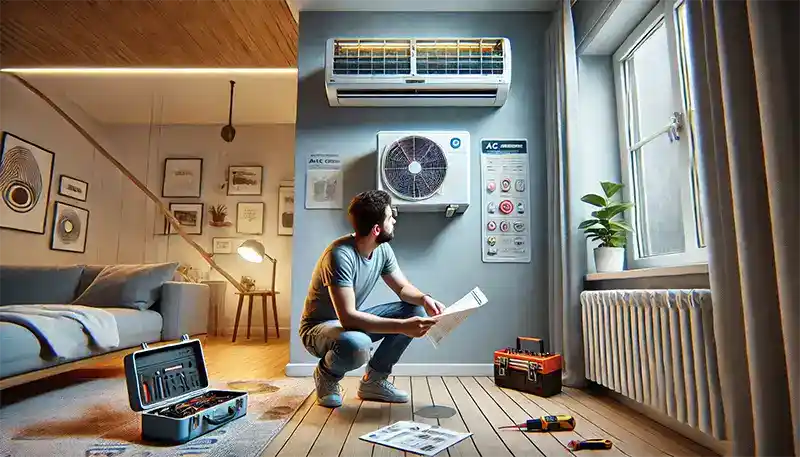
When your AC system malfunctions, it can be stressful, especially during peak summer months. Here’s a guide on common problems, quick fixes, and when to call a professional.
Common Problems and Quick Fixes:
- Thermostat Issues: If your AC isn’t turning on, start by checking the thermostat. Ensure it’s set to “cool” and that the temperature setting is below the current room temperature. Replace the batteries if needed. According to Energy Star, a malfunctioning thermostat is a common cause of AC issues.
- Unusual Noises: Loud or unusual noises from your AC unit can indicate various issues. Rattling may suggest loose parts, while a screeching sound might mean a problem with the fan motor. Inspect for loose screws or debris around the unit and tighten or clean as necessary. Squealing sounds often indicate a worn-out belt, which might need replacement.
- Poor Airflow: If your AC is running but not cooling effectively, check the filters. Clogged filters restrict airflow, reducing efficiency. Clean or replace the filters every 1-3 months. Also, inspect the ducts for leaks or blockages, as recommended by the Department of Energy. Additionally, ensure that vents and registers are open and not obstructed by furniture or other objects.
- System Not Turning On: In addition to checking the thermostat, ensure the circuit breaker hasn’t tripped. Reset it if necessary. Also, check the AC disconnect switch near the outdoor unit and make sure it’s in the “on” position. If these don’t resolve the issue, the problem could be a faulty capacitor or contactor, which requires professional attention.
- Refrigerant Leaks: If your AC is low on refrigerant, it won’t cool properly. Signs of a refrigerant leak include hissing noises and ice buildup on the evaporator coil. While you can’t fix this yourself, recognizing the signs can help when you call a professional. The Environmental Protection Agency highlights the importance of proper refrigerant levels for efficiency and safety.
When to Troubleshoot vs. When to Call a Professional:
DIY Fixes:
Replace filters, check thermostat settings, and clean accessible parts.
If the condenser stops spinning, check the AC disconnect fuse, the maintenance switch, the thermostat setting, and the circuit breaker.
Clean the outdoor unit by removing debris and ensuring the coils are not blocked.
Professional Help:
Electrical Issues: If your AC unit frequently trips the circuit breaker or you suspect electrical problems, it’s time to call an expert.
Refrigerant Leaks: As mentioned, refrigerant issues should be handled by a professional due to the complexity and environmental regulations.
Major Component Failures: Problems like a failed compressor, motor, or fan need professional diagnosis and repair. The Air Conditioning Contractors of America recommends annual professional maintenance to prevent these issues.
Persistent Problems: If you’ve tried basic troubleshooting and the issue persists, calling a professional can save time and prevent further damage.
System Not Cooling Properly: If your system is running but not cooling efficiently despite all DIY fixes, it could be a sign of more significant issues such as low refrigerant, a malfunctioning compressor, or duct leaks, all of which require professional expertise.
Preventive Measures:
- Schedule regular professional maintenance to keep your system running efficiently. Annual inspections can identify and fix small issues before they become major problems.
- Replace or clean air filters regularly to maintain good airflow and efficiency.
- Keep the area around the outdoor unit clear of debris and vegetation to ensure proper airflow.
- Install a programmable thermostat to optimize cooling schedules and reduce unnecessary strain on your system.
By addressing minor issues promptly and knowing when to call in an expert, you can ensure your AC system remains efficient and reliable.
How Much AC Systems Cost
The cost of air conditioning systems varies widely depending on the type of system, its efficiency, installation complexity, and maintenance requirements. Here’s a breakdown of the costs associated with different AC systems, tailored for Kansas City homeowners.
Installation Costs:
- Central Air Conditioning: Installing a central AC system in Kansas City typically costs between $3,000 and $7,000. This price range reflects the cost of the unit, ductwork, and labor. According to HomeAdvisor, central AC units provide comprehensive cooling for the entire home, making them a popular choice in the Midwest where summers can be hot and humid. Look for units with high SEER (Seasonal Energy Efficiency Ratio) ratings for better energy savings.
- Ductless Mini-Split: The cost of installing a ductless mini-split system ranges from $2,000 to $5,000 per zone. Angi notes that these systems are ideal for older homes or those without existing ductwork. Their flexibility makes them a good choice for room additions or areas that need supplemental cooling. High-efficiency mini-splits can have SEER ratings upwards of 20.
- Air-to-Air Heat Pumps: These systems cost between $4,000 and $8,000 to install. The U.S. Department of Energy highlights that heat pumps offer both heating and cooling, which can lead to overall savings in regions with milder winters and hot summers like Kansas City. Modern units often have SEER ratings from 14 to 20.
- Ground Source (Geothermal) Heat Pumps: Geothermal heat pumps have a higher installation cost, typically ranging from $10,000 to $30,000. Energy.gov points out that despite the high upfront cost, these systems offer significant long-term savings and efficiency, which can be particularly beneficial in Kansas City’s variable climate. The efficiency of geothermal systems can be measured by their COP (Coefficient of Performance), often ranging from 3.5 to 4.5.
- Swamp Coolers (Evaporative Coolers): Installation costs for swamp coolers range from $500 to $2,000. However, these systems are less common in Kansas City due to the region’s humidity. The National Renewable Energy Laboratory notes that swamp coolers are more effective in dry climates, making them less suitable for the Midwest.
Maintenance Costs:
- Central Air Conditioning: Annual maintenance for central AC systems in Kansas City typically costs between $100 and $300. This includes routine checks, filter replacements, and cleaning coils. Regular maintenance can prevent costly repairs and extend the system’s lifespan.
- Ductless Mini-Split: Mini-split systems require maintenance ranging from $150 to $300 annually. They require regular filter cleaning and occasional professional inspections to ensure optimal performance.
- Air-to-Air Heat Pumps: Annual maintenance costs are similar to central AC systems, typically between $150 and $300. Regular checks on refrigerant levels and system components are crucial for maintaining efficiency.
- Ground Source (Geothermal) Heat Pumps: Maintenance costs for geothermal systems are slightly higher, ranging from $200 to $500 per year. These costs cover inspections of the indoor unit and the ground loop system.
- Swamp Coolers (Evaporative Coolers): Annual maintenance costs are low, usually between $100 and $200. This includes replacing cooling pads, checking the water pump, and ensuring proper drainage.
Repair Costs:
- Central Air Conditioning: Repair costs can vary widely, from $150 for minor fixes to over $1,000 for major repairs like compressor replacements. HomeAdvisor provides detailed estimates for common AC repairs.
- Ductless Mini-Split: Depending on the issue, repairs typically cost between $200 and $1,000. Common repairs include fixing refrigerant leaks and replacing faulty components.
- Air-to-Air Heat Pumps: Repair costs range from $150 to $1,000, similar to central AC systems. Issues with the reversing valve or defrost control are common and require professional attention.
- Ground Source (Geothermal) Heat Pumps: Due to the complexity of the system, repairs can be more expensive, ranging from $300 to $2,000. Major repairs might involve the ground loop system, which can be costly.
- Swamp Coolers (Evaporative Coolers): Repair costs are generally low, from $100 to $500. Common repairs include fixing the water pump and replacing pads.
Total Cost of Ownership:
Considering both upfront and ongoing costs, here’s a quick comparison:
- Central AC: Higher initial cost but reliable and effective for large homes. Energy-efficient models can significantly reduce operational costs.
- Ductless Mini-Split: Flexible and efficient, with moderate installation and maintenance costs. High SEER ratings can lead to substantial energy savings.
- Air-to-Air Heat Pumps: Dual function with moderate initial and maintenance costs. High efficiency in mild climates makes them cost-effective.
- Geothermal Heat Pumps: High initial cost with significant long-term savings and efficiency. Their durability and low operating costs make them a long-term investment.
- Swamp Coolers: Low initial and maintenance costs, best for dry climates, less effective in Kansas City due to humidity.
Local Incentives:
Kansas City homeowners may also benefit from local incentives and rebates for installing energy-efficient AC systems. Check with Evergy and the Missouri Department of Natural Resources for available programs that can help offset installation costs.
Heating Systems
What are the Various Types of Heating Systems?
When it comes to heating your home, you have several options. Each type of system has its own advantages and works best under specific conditions. Let’s break it down:
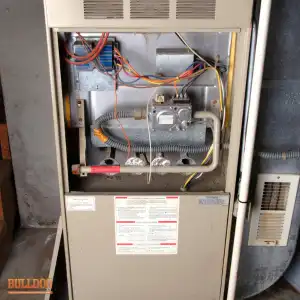
Furnaces: These systems heat air and distribute it through your house via ducts. They’re common in many homes and are known for providing consistent heat. Furnaces can be powered by gas, electricity, or oil.
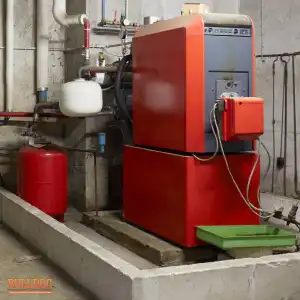
Boilers: Unlike furnaces, boilers heat water to provide either hot water or steam for heating. The heated water or steam travels through pipes to radiators or underfloor systems. Boilers are efficient and provide steady, even heating.
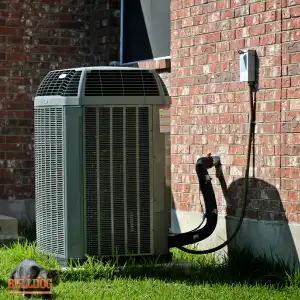
Air-to-Air Heat Pumps: These systems transfer heat between your house and the outside air. They provide both heating and cooling, making them versatile. Air-to-air heat pumps are most effective in milder climates.
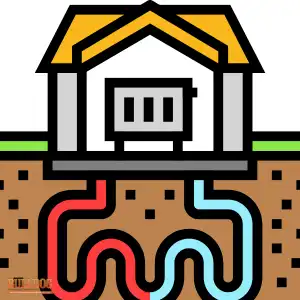
Ground-Source (Geothermal) Heat Pumps: Dig into the ground to use the earth’s consistent temperature for heating and cooling. They are highly efficient and environmentally friendly, even though they have higher installation costs.
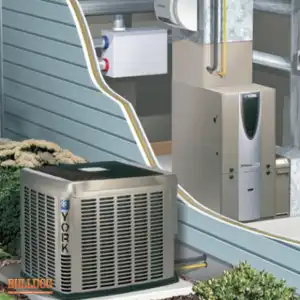
Hybrid Systems: These combine a heat pump with a furnace. The heat pump is used for energy-efficient heating and cooling during milder weather, while the furnace kicks in during extremely cold weather to provide additional heat. This combination ensures better energy efficiency year-round.
By understanding the different types of heating systems, you can choose the one that best suits your needs and the climate in your area. For a detailed look at where these systems are most commonly used, check out this map of the US showing regional preferences.
Where You’ll Find the Various Types of Heating Systems
Heating systems are not one-size-fits-all. Different types are favored in different settings, whether it’s residential or commercial buildings, or based on regional preferences.
RESIDENTIAL vs. COMMERCIAL BUILDINGS
Residential: Furnaces and boilers are the go-to for many homes, providing reliable and efficient heating. They’re often found in single-family homes and small apartment buildings. In the U.S., about 47% of homes use natural gas furnaces. Electric furnaces are less common but still present, particularly in regions with lower electricity costs.
Commercial: Larger buildings like offices, schools, and hospitals often use boilers or commercial-grade furnaces, which can handle higher demands. Heat pumps are also common in newer commercial buildings for their efficiency and dual heating/cooling capabilities. Around 40% of commercial buildings in the U.S. utilize boilers.
REGIONAL PREFERENCES
Colder Regions: In areas with harsh winters, like the Midwest and Northeast, furnaces and boilers dominate. These systems are built to handle extreme cold and provide consistent warmth. For example, about 60% of homes in the Northeast use boilers. Natural gas furnaces are also very common in the Midwest due to the abundant gas supply and infrastructure.
Milder Climates: In places like the South and West Coast, heat pumps are more prevalent. They offer both heating and cooling, making them ideal for regions with moderate weather. Over 50% of new homes in the South use heat pumps, which are particularly effective in areas that don’t experience prolonged cold spells.
Hybrid Systems: These are popular in areas with variable temperatures, such as the Midwest, where homeowners need both robust heating and cooling options. Hybrid systems provide the flexibility needed to handle diverse weather conditions efficiently, combining the efficiency of heat pumps with the power of furnaces.
Understanding where different heating systems are commonly used can help you make an informed decision about what’s best for your home or business.
When Different Types of Heating Systems Were Used Through Time
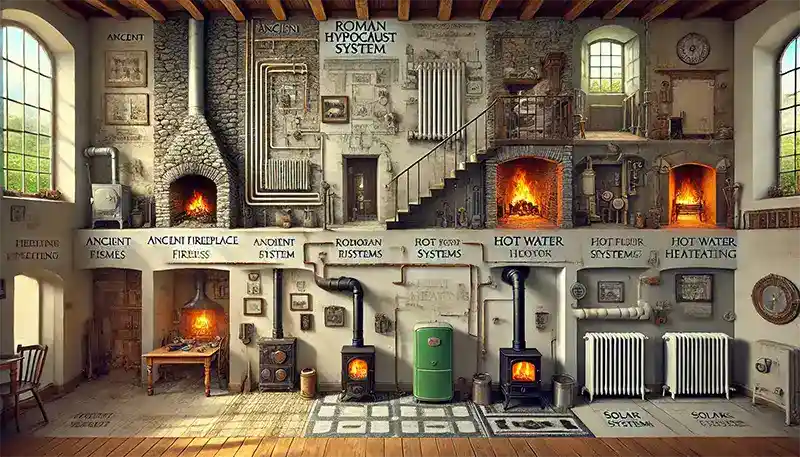
Heating systems have evolved dramatically over the years. From basic wood stoves to modern geothermal heat pumps, each era brought advancements that made our homes warmer and more efficient. Let’s dive into the history of heating systems and see how they developed over time.
- Early 1900s: Most homes relied on wood and coal stoves. These were simple but required constant attention to keep the fire going. Stoves were typically located in central areas to distribute heat as evenly as possible. Despite their inefficiency, they were a staple in American homes during this period.
- 1920s-1930s: The introduction of central heating systems marked a significant shift. Furnaces and boilers began to replace stoves, offering a more reliable and consistent source of heat. These systems used coal and later transitioned to oil and gas as fuel sources became more accessible and affordable. By the 1930s, about 42% of American homes had some form of central heating system.
- 1950s-1960s: This era saw a boom in suburban development, leading to widespread adoption of central heating systems in new homes. Natural gas furnaces became more common due to their efficiency and the growing gas infrastructure. By the 1960s, over 50% of U.S. homes were heated by natural gas furnaces.
- 1970s: The energy crisis of the 1970s spurred innovation in heating technology. Heat pumps gained popularity due to their ability to provide both heating and cooling efficiently. This period saw the rise of air-to-air heat pumps, which became a common choice in new homes. Their dual functionality and improved efficiency made them an attractive option as energy prices soared.
- 1980s-1990s: The focus shifted towards energy efficiency and the environment. High-efficiency gas furnaces and boilers, with AFUE ratings of 90% or higher, became the standard. The use of programmable thermostats also increased, allowing homeowners to better control their heating systems and reduce energy consumption.
- 1990s-Present: The focus shifted towards energy efficiency and sustainability. Geothermal heat pumps, which utilize the earth’s stable temperature, have become more widespread. These systems, though initially more expensive to install, offered significant savings on energy bills and reduced environmental impact. The push for greener technologies also led to the development of hybrid systems, combining the best features of heat pumps and furnaces. Today, about 12% of homes in the U.S. use geothermal heat pumps.
- 2000s-Present: The rise of smart home technology has further revolutionized heating systems. Smart thermostats and home automation systems allow for precise control over heating, improving both comfort and energy efficiency. Many modern systems also integrate renewable energy sources, such as solar panels, to further reduce environmental impact.
The journey of heating systems from wood stoves to modern heat pumps reflects our ongoing quest for comfort, efficiency, and sustainability. Each innovation has built upon the last, paving the way for the advanced systems we rely on today.
What Maintenance Each Heating System Needs
Regular maintenance is crucial to ensure your heating system runs efficiently and lasts as long as possible. Here’s a breakdown of the maintenance tasks needed for different types of heating systems and their expected lifespans.
- Furnaces: Furnaces can last 20-25 years with proper care. To keep them running smoothly:
- Inspecting and Cleaning Burners: Dirty burners can cause inefficient operation and even pose safety risks. Check and clean them annually to ensure proper combustion. According to Energy Star, clean burners improve efficiency significantly.
- Checking and Replacing Filters: Replace or clean filters every 1-3 months. A clogged filter makes your furnace work harder, reducing its efficiency and lifespan. Regular filter changes can improve air quality and system performance.
- Regular Professional Inspections: Schedule annual inspections to check for issues like cracks in the heat exchanger or faulty thermostats. These inspections can help catch problems early and extend the life of your furnace. The Department of Energy notes that regular maintenance can improve efficiency by up to 15%.
- Boilers: Boilers generally last 15-20 years. Their maintenance includes:
- Flushing the System: Over time, sediment can build up in the boiler and pipes, reducing efficiency and potentially causing damage. Flushing the system annually helps prevent these issues.
- Inspecting the Pressure Valve: The pressure valve needs to be checked regularly to ensure it’s operating correctly and maintaining the proper pressure levels in the system.
- Checking the Water Level: Maintain the correct water level to ensure the boiler operates efficiently. Low water levels can cause severe damage. Annual inspections can help identify and rectify water level issues. According to HVAC system experts, keeping the water level in check is crucial for the boiler’s longevity.
- Heat Pumps: With good maintenance, heat pumps can last 20-25 years. Here’s what they need:
- Cleaning Coils and Fans: Dust and dirt can accumulate on the coils and fans, reducing efficiency. Clean these components regularly to keep the system running smoothly.
- Checking Refrigerant Levels: Proper refrigerant levels are essential for the heat pump to operate efficiently. Low levels can indicate leaks or other issues that need professional attention. HVAC professionals stress the importance of maintaining proper refrigerant levels.
- Inspecting Electrical Components: Regularly check and tighten electrical connections. Loose connections can cause the system to fail or operate inefficiently.
- Hybrid Systems: These systems combine a heat pump with a furnace, requiring maintenance for both components:
- Regular Maintenance of Both Systems: Follow the maintenance guidelines for both heat pumps and furnaces as mentioned above. Ensuring both components are well-maintained will maximize the system’s efficiency and lifespan. Regular checks can prevent unexpected breakdowns, especially during extreme weather.
Regular maintenance not only extends the life of your heating system but also ensures it operates efficiently, saving you money on energy bills. For example, Energy Star states that a well-maintained system can reduce energy consumption by up to 30% annually.
Benefits of Regular Professional Heating System Maintenance
- Improved Efficiency: Regular professional maintenance can improve your system’s efficiency, leading to lower energy bills. The U.S. Department of Energy notes that well-maintained systems can save up to 30% on energy costs.
- Extended Lifespan: Professional maintenance helps identify and fix small issues before they become major problems, extending the lifespan of your heating system.
- Enhanced Comfort: A well-maintained system provides more reliable and consistent heating, ensuring your home stays comfortable throughout the winter.
What to Expect from Each Heating System
Choosing a heating system isn’t just about picking the right type. It’s also about understanding the performance, quirks, and potential issues of each system. Here’s what you can expect:
Furnaces:
Performance: Furnaces provide consistent heat and can quickly warm up your home. They are particularly effective in cold climates and offer high efficiency, with models reaching up to 98.5% AFUE. Due to their reliability, furnaces are the backbone of many home heating systems.
Common Issues: Furnaces can sometimes have problems with gas leaks, especially if they’re not maintained regularly. It’s crucial to check for leaks to prevent dangerous situations. They also require regular filter changes to avoid reduced efficiency and poor indoor air quality.
Quirks: Furnaces can be noisy when they kick on, which might be bothersome for some homeowners. Additionally, because they use ducts, they can spread dust and allergens if filters aren’t changed regularly.
Boilers:
Performance: Boilers offer steady and even heating, making them a great choice for homes with radiators or in-floor heating. They tend to be more efficient than forced-air systems and can reach efficiency levels up to 95% AFUE. Boilers are known for their durability and longevity, often outlasting other types of heating systems.
Common Issues: Boilers can suffer from water leaks and pressure issues. Regular maintenance is essential to check for leaks and to ensure the pressure is at the right level. Sediment build-up in the boiler can also reduce efficiency and needs to be flushed out annually.
Quirks: Boilers take longer to heat up compared to furnaces, which might be a drawback if you need quick warmth. They also require more space due to the size of the unit and the need for a separate water tank.
Heat Pumps:
Performance: Heat pumps are incredibly energy-efficient, providing both heating and cooling. They’re best suited for milder climates but can be effective in colder areas when paired with a supplemental heating source. Modern heat pumps can achieve SEER ratings up to 20 and HSPF ratings of 10. According to the U.S. Department of Energy, heat pumps can reduce electricity use for heating by approximately 50% compared to electric resistance heating.
Common Issues: Heat pumps can become less efficient in extremely cold weather, which is why they might need a backup heating system. Ice build-up on the outdoor unit can also be an issue, requiring regular checks and maintenance.
Quirks: Heat pumps can sometimes struggle to maintain a constant temperature in very cold weather, leading to increased use of auxiliary heat, which can drive up energy costs. However, their ability to provide cooling as well as heating makes them versatile.
Hybrid Systems:
Performance: Hybrid systems combine the efficiency of heat pumps with the reliability of furnaces. They automatically switch between the heat pump and the furnace depending on the outside temperature, ensuring optimal efficiency and comfort year-round. This adaptability makes hybrid systems highly efficient, potentially saving homeowners up to 30% on energy costs annually according to Energy Star.
Common Issues: The complexity of maintaining two systems in one can lead to higher maintenance costs. It’s essential to ensure both the heat pump and the furnace components are regularly serviced.
Quirks: Hybrid systems are typically more expensive to install because they require both a heat pump and a furnace. However, they can offer significant energy savings in the long run, especially in regions with variable temperatures.
Understanding what to expect from each heating system can help you make a more informed decision and prepare for any potential issues. Regular maintenance and being aware of common problems can extend the lifespan and improve the efficiency of your heating system, saving you money and hassle in the long run.
How Long Each Heating System Should Last
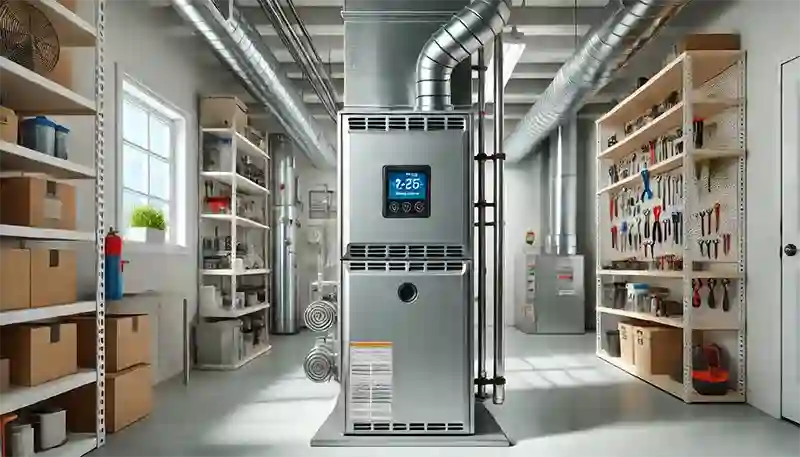
When investing in a heating system, it’s crucial to consider its lifespan. Knowing how long your system will last helps in planning maintenance and budgeting for eventual replacements. Here’s a look at the average lifespan of different heating systems and the factors that influence their longevity.
Furnaces:
Average Lifespan: Furnaces typically last 20-25 years. Modern furnaces, with proper maintenance, can reach the upper end of this range.
Factors Influencing Lifespan: Regular maintenance is key to extending a furnace’s life. This includes annual inspections, timely filter changes, and ensuring that all components are functioning correctly. The type of fuel used (natural gas, oil, or electricity) can also affect durability, with natural gas furnaces generally having longer lifespans due to cleaner combustion processes.
Signs of Aging: Increased frequency of repairs, higher energy bills, uneven heating, and strange noises.
Data Point: According to the National Association of Home Builders, the average lifespan of a furnace is about 20 years, but with advancements in technology and better materials, newer models often exceed this.
Boilers:
Average Lifespan: Boilers usually last 15-20 years. High-quality boilers and those subjected to regular maintenance can sometimes last even longer.
Factors Influencing Lifespan: Key maintenance tasks include checking the water level, pressure, and flushing the system to remove sediment buildup. Additionally, ensuring that the boiler is not overworked by matching its capacity to the home’s heating demands can help prevent premature wear and tear.
Signs of Aging: Water leaks, decreased efficiency, strange noises, and frequent need for repairs.
Data Point: The U.S. Department of Energy states that while older boilers can last 15 years, newer, high-efficiency models can last up to 25 years with proper care.
Heat Pumps:
Average Lifespan: Heat pumps have an average lifespan of 20-25 years. Their longevity is highly dependent on climate and usage patterns.
Factors Influencing Lifespan: Regular maintenance such as cleaning coils and fans, checking refrigerant levels, and ensuring proper operation of electrical components is crucial. Heat pumps in milder climates tend to last longer because they don’t have to work as hard to maintain comfortable temperatures.
Signs of Aging: Reduced efficiency, increased noise levels, frequent switching on and off, and higher energy bills.
Data Point: As per Energy Star, heat pumps can last up to 25 years, particularly when they are well-maintained and not overused.
Hybrid Systems:
Average Lifespan: Hybrid systems generally last 20-25 years. They combine the longevity of furnaces and heat pumps, leveraging the strengths of both systems.
Factors Influencing Lifespan: The complexity of hybrid systems means that regular maintenance of both the heat pump and the furnace components is essential. Ensuring that the system switches efficiently between the two modes can also prevent excessive wear on either component.
Signs of Aging: Inconsistent heating, increased energy consumption, frequent repairs, and operational noise.
Data Point: According to Energy.gov, hybrid systems can be highly durable, offering a lifespan comparable to or even exceeding that of traditional heating systems when properly maintained.
Understanding your heating system’s expected lifespan can help you make informed decisions about maintenance, upgrades, and replacements. Regular care and mindful usage are the keys to maximizing its life and efficiency, ensuring comfort and savings over the long term.
What to Do When Something Goes Wrong with Your Heating System
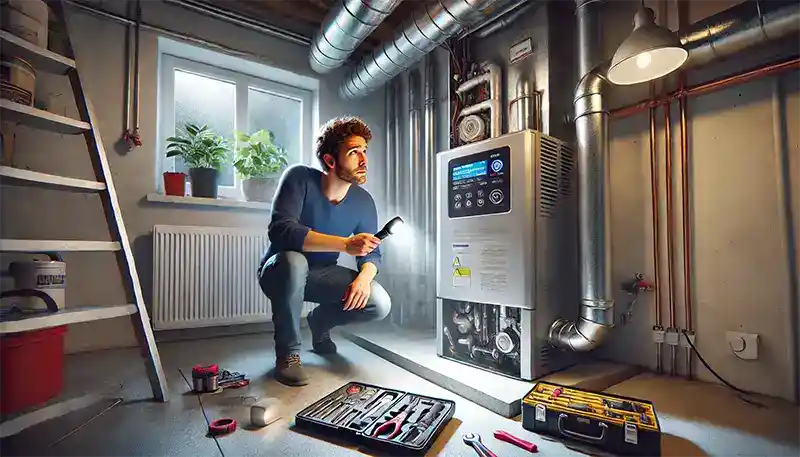
Even the best-maintained heating systems can experience problems. Knowing how to troubleshoot common issues and when to call a professional can save you time, money, and frustration. Here’s a guide to handling heating system troubles:
Thermostat Issues:
Common Problems: Incorrect settings, dead batteries, or wiring issues.
Quick Fixes: Start by checking that the thermostat is set to the correct mode (heat) and temperature. Replace the batteries if they are dead. If the thermostat is still unresponsive, ensure the wiring is properly connected. For a detailed guide on thermostat troubleshooting, see Home Depot’s thermostat troubleshooting tips.
Unusual Noises:
Common Problems: Loose parts, debris in the system, or failing components.
Quick Fixes: Turn off the system and inspect it for any loose parts. Tighten any screws or bolts that may have come loose. Clean out any visible debris. If the noise persists, it could indicate a more serious issue like a failing motor or blower, which requires professional attention.
Uneven Heating:
Common Problems: Clogged filters, blocked vents, or duct issues.
Quick Fixes: Start by cleaning or replacing the filters. Ensure all vents are open and not blocked by furniture or other objects. Inspect the ductwork for leaks or blockages. For more in-depth duct inspection tips, check out Energy Star’s guide.
System Not Turning On:
Common Problems: Power issues, tripped circuit breakers, or faulty components.
Quick Fixes: Verify that the system is receiving power. Check the circuit breaker and reset it if necessary. Ensure the thermostat is functioning correctly. If the system still doesn’t turn on, it might be an issue with the internal components like the blower motor or igniter, which needs a professional diagnosis.
When to Troubleshoot vs. When to Call a Professional
DIY Fixes:
Simple tasks like replacing filters, checking thermostat settings, and cleaning accessible parts can often be done without professional help. Regular maintenance, as outlined in your system’s manual, can prevent many common issues and extend the lifespan of your heating system.
Professional Help:
Electrical issues, gas leaks, major component failures, and persistent problems should always be handled by a professional. Attempting to fix these issues yourself can be dangerous and may void your system’s warranty. For example, if you suspect a gas leak, immediately turn off the system and contact your utility provider or a licensed HVAC system technician. The EPA provides resources on finding certified HVAC system professionals.
Maintenance Contracts:
Consider signing a maintenance contract with a trusted HVAC system service provider. These contracts typically include regular inspections, priority service, and discounts on repairs, ensuring your system stays in top condition year-round. According to Consumer Reports, regular maintenance can prevent 90% of all HVAC system breakdowns.
Safety First
- Immediate Shut Down: If you smell gas, hear a loud bang, or see smoke, shut down your heating system immediately. Vacate your home and call emergency services. These are signs of serious issues that need immediate professional intervention.
- Carbon Monoxide Detectors: Ensure your home has working carbon monoxide detectors, especially if you use a gas furnace or boiler. These devices can alert you to dangerous CO levels, preventing potential poisoning.
Knowing how to handle common heating system problems and when to seek professional help ensures that your home stays warm and safe. Regular maintenance and timely repairs can save you from costly breakdowns and improve the efficiency and longevity of your heating system.
When to Call a Professional for Your Heating System
While some heating system issues can be resolved with basic troubleshooting, there are times when it’s essential to call in a professional. Here’s how to know when you need expert help:
Persistent Problems:
Common Signs: If your heating system has recurring issues despite your best DIY efforts, it’s time to call a professional. Persistent problems can indicate deeper issues that require specialized knowledge and tools to diagnose and fix. For instance, if your furnace repeatedly cycles on and off, it could be due to an overheating issue or a malfunctioning thermostat that needs professional attention.
Strange Odors or Leaks:
Common Signs: Unusual smells, especially the scent of gas or burning, are red flags. If you detect a gas odor, evacuate your home immediately and contact your gas company or emergency services. Water leaks around a boiler or unusual humidity around a heat pump also require professional evaluation. The Consumer Product Safety Commission warns that gas leaks can be extremely dangerous, leading to explosions or carbon monoxide poisoning.
System Not Turning On:
Common Signs: If your heating system fails to turn on, it could be due to a variety of issues, including electrical problems, failed components, or safety switch triggers. A professional can perform a thorough diagnosis to identify and fix the underlying issue.
Gas Smell:
Immediate Action: If you smell gas, this is a serious emergency. Shut off the system, evacuate your home, and contact your utility provider or emergency services. Do not attempt to fix the issue yourself. The National Fire Protection Association emphasizes the importance of professional intervention in gas-related emergencies to prevent potential disasters.
Unusual Noises:
Common Signs: Persistent banging, clanking, or squealing noises from your heating system are not normal and can indicate mechanical issues. Components like the blower motor, bearings, or belts may need professional inspection and replacement.
Frequent Cycling:
Common Signs: If your heating system frequently turns on and off, it can be due to an oversized system, thermostat issues, or airflow problems. A professional can assess and rectify the situation to prevent energy waste and wear on the system.
Why Professional Help is Important
- Safety Concerns: Professionals are trained to handle hazardous situations, such as gas leaks or electrical failures, safely and effectively. Attempting to fix these problems yourself can be dangerous and may lead to severe consequences.
- Specialized Tools and Knowledge: HVAC system professionals have access to specialized tools and extensive training that allow them to diagnose and repair issues accurately. This expertise ensures that problems are resolved correctly the first time, preventing further damage or recurrence.
- Warranty Protection: Many heating systems come with warranties that require professional maintenance and repairs. DIY fixes can void these warranties, leading to higher costs in the long run. Check your system’s warranty details to understand the requirements for professional servicing.
When in Doubt, Call a Pro
If you’re ever unsure whether a problem requires professional help, it’s better to err on the side of caution. Contacting a professional ensures that your heating system is repaired safely and efficiently, maintaining your home’s comfort and your family’s safety. The Better Business Bureau suggests choosing a certified and reputable HVAC system contractor to guarantee quality service.
How Much Heating Systems Cost
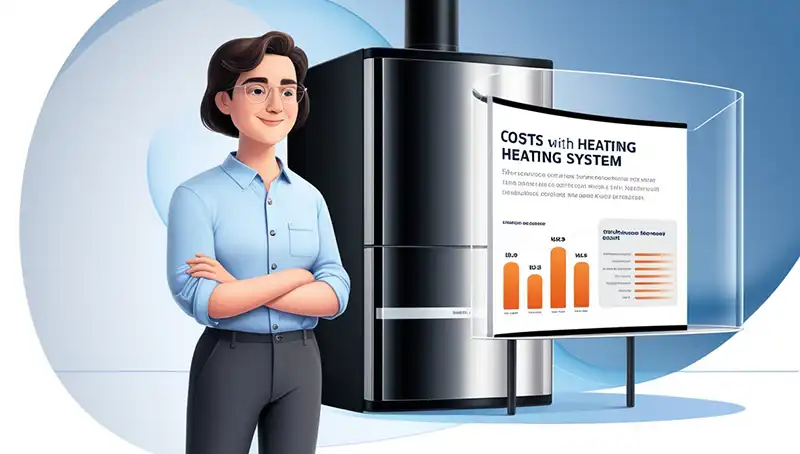
Investing in a new heating system involves considering not just the upfront cost but also installation, maintenance, and potential repair costs. Here’s a breakdown of what you can expect to pay for heating systems in Kansas City:
Furnaces:
Installation Costs: The cost to install a furnace in Kansas City typically ranges from $3,000 to $5,500, depending on the type and efficiency of the unit. High-efficiency models can be more expensive but offer greater savings on energy bills over time.
Maintenance Costs: Annual maintenance costs for a furnace average around $150 to $300. This includes inspections, filter changes, and minor repairs to keep the system running efficiently.
Repair Costs: Common repairs, such as fixing a blower motor or replacing a thermostat, can cost between $200 and $1,500. According to HomeAdvisor, the average furnace repair in Kansas City costs about $300.
Boilers:
Installation Costs: Installing a boiler in Kansas City generally costs between $4,000 and $7,000. This price can vary based on the size of the unit, its efficiency, and whether it’s a standard or high-efficiency model.
Maintenance Costs: Annual maintenance for boilers runs about $200 to $400. Regular maintenance includes checking the water levels and pressure and flushing the system to prevent sediment buildup.
Repair Costs: Boiler repairs, such as fixing leaks or replacing valves, can range from $150 to $1,200. According to Homeguide, the average cost for boiler repair in Kansas City is around $400.
Heat Pumps:
Installation Costs: The cost to install a heat pump in Kansas City ranges from $5,000 to $8,500. The total price depends on whether it’s an air-to-air or ground source (geothermal) heat pump, with geothermal systems being more expensive due to the extensive installation process.
Maintenance Costs: Annual maintenance costs for heat pumps are typically between $200 and $500. This includes cleaning coils, checking refrigerant levels, and inspecting electrical components.
Repair Costs: Heat pump repairs, such as fixing a refrigerant leak or replacing a compressor, can cost between $250 and $2,000. The average repair cost in Kansas City is around $600, based on data from Angi.
Hybrid Systems:
Installation Costs: Installing a hybrid system, which combines a heat pump with a furnace, generally costs between $7,000 and $12,000 in Kansas City. This higher cost reflects the complexity and efficiency of the system.
Maintenance Costs: Maintenance costs for hybrid systems are higher, averaging $300 to $600 annually, as they require upkeep for both the heat pump and furnace components.
Repair Costs: Repairs for hybrid systems can vary widely, with common issues costing between $300 and $2,500. The average repair cost for hybrid systems in Kansas City is about $900, according to HomeAdvisor.
Additional Costs to Consider
- Energy Costs: The type of heating system you choose will impact your energy bills. High-efficiency systems, while more expensive upfront, can significantly reduce your monthly energy costs. For instance, the U.S. Department of Energy notes that high-efficiency furnaces and boilers can save homeowners up to 30% on energy bills annually.
- Rebates and Incentives: Many high-efficiency heating systems qualify for rebates and incentives, which can help offset the initial cost. Check with local utility companies and the Database of State Incentives for Renewables & Efficiency (DSIRE) for available programs in Kansas City.
- Warranties and Service Contracts: Investing in extended warranties or service contracts can provide peace of mind and reduce unexpected repair costs. These contracts typically cost between $150 and $500 per year, depending on the coverage.
- Financing Options: Many HVAC system companies offer financing options to help spread the cost of a new heating system over time. This can make it easier to afford a high-efficiency model that will save money in the long run. Look for low-interest financing or deferred payment plans.
Understanding the costs associated with heating systems helps you make an informed decision that fits your budget and heating needs. Regular maintenance and investing in high-efficiency models can lead to long-term savings and improved comfort in your home.
Energy Efficiency and Environmental Impact
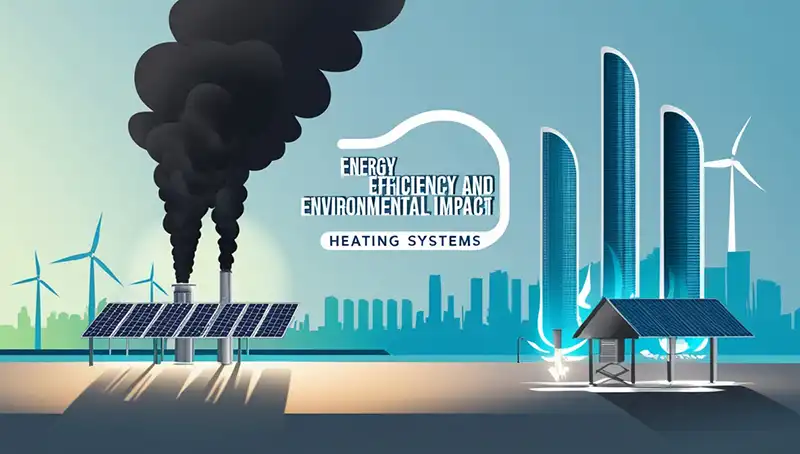
Choosing an energy-efficient heating system isn’t just about saving money on your energy bills—it’s also about reducing your environmental footprint. Here’s how different heating systems stack up in terms of efficiency and environmental impact:
Furnaces:
Efficiency: Modern furnaces, especially those with high AFUE ratings (Annual Fuel Utilization Efficiency), can achieve up to 98.5% efficiency. This means nearly all the fuel consumed is converted into heat for your home.
Environmental Impact: High-efficiency furnaces reduce greenhouse gas emissions by burning fuel more completely. However, natural gas furnaces still produce CO2, a greenhouse gas. Choosing a high-efficiency model and maintaining it properly can minimize these emissions.
Market Data: According to the U.S. Energy Information Administration, natural gas furnaces are the most common in the U.S., heating about 49% of homes. Their efficiency improvements over the past decades have significantly reduced their environmental impact.
Boilers:
Efficiency: Boilers can be highly efficient, with some models reaching up to 95% AFUE. Condensing boilers are particularly efficient, as they recover heat from exhaust gases.
Environmental Impact: Like furnaces, high-efficiency boilers reduce emissions by burning fuel more efficiently. They can also use alternative fuels like biodiesel blends, which can further reduce their carbon footprint.
Market Data: Boilers are more common in older homes and in regions like the Northeast. The shift towards high-efficiency models has helped lower the overall emissions from home heating.
Heat Pumps:
Efficiency: Heat pumps are among the most energy-efficient heating systems, with air-source heat pumps achieving SEER ratings up to 20 and geothermal (ground-source) heat pumps reaching COPs (Coefficient of Performance) of 3.5 to 5.
Environmental Impact: Heat pumps have a lower environmental impact compared to fossil fuel-based systems. They use electricity, which can be generated from renewable sources, further reducing their carbon footprint. Geothermal heat pumps, in particular, are highly sustainable.
Market Data: The popularity of heat pumps is growing, especially in milder climates. According to the International Energy Agency, heat pump installations are increasing by about 10% annually worldwide, driven by their efficiency and environmental benefits.
Hybrid Systems:
Efficiency: Hybrid systems, which combine a heat pump with a furnace, optimize efficiency by switching between the two systems based on temperature. This ensures the most efficient operation throughout the year.
Environmental Impact: Hybrid systems reduce overall fuel consumption and emissions by utilizing a heat pump for milder weather and a furnace for extreme cold. They offer a balanced approach, leveraging the strengths of both systems.
Market Data: Hybrid systems are becoming more popular in regions with variable climates. The ability to optimize energy use year-round makes them an attractive choice for environmentally conscious homeowners.
Benefits of Energy-Efficient Systems
- Reduced Energy Bills: High-efficiency systems use less energy to produce the same amount of heat, which translates to lower utility bills. According to the U.S. Department of Energy, switching to a high-efficiency furnace or boiler can save you up to 30% on your heating costs.
- Lower Carbon Footprint: Efficient heating systems produce fewer emissions, helping to reduce your home’s overall carbon footprint. This is particularly important as we aim to mitigate climate change impacts.
- Increased Home Comfort: Energy-efficient systems often provide more consistent and reliable heating, improving overall home comfort. They also tend to be quieter and require less maintenance.
Environmental Incentives
Many governments and utilities offer incentives for installing high-efficiency heating systems. These can include tax credits, rebates, and low-interest financing options. Programs like the Energy Star federal tax credits for energy efficiency can help offset the initial cost of a new system, making it more affordable to go green.
Incentives in Kansas City
- Utility Rebates: Evergy offers rebates for high-efficiency heating systems. Check their rebate program for the latest incentives.
- State Incentives: Missouri offers various incentives for energy-efficient home improvements. Visit the Database of State Incentives for Renewables & Efficiency (DSIRE) to find out more.
- Federal Tax Credits: Homeowners can take advantage of federal tax credits for installing energy-efficient systems. For detailed information, see the Energy Star website.
Understanding the energy efficiency and environmental impact of your heating system helps you make informed choices that benefit both your wallet and the planet. Investing in high-efficiency systems and utilizing available incentives can lead to significant long-term savings and a healthier environment.
Smart HVAC System and Technology Integration
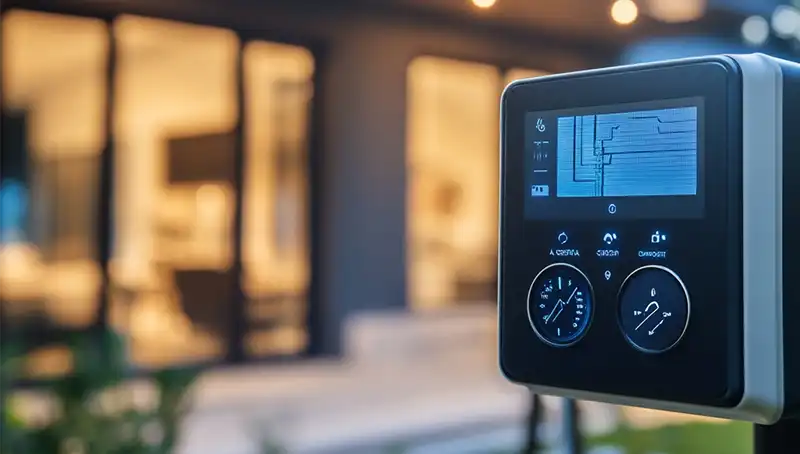
For Kansas City homeowners looking to maximize comfort and efficiency, integrating smart technology with your HVAC system can be a game-changer. Smart HVAC systems offer a blend of convenience, energy savings, and enhanced control over your home environment. Here’s how these systems can benefit you and what the latest technology has to offer:
Smart Thermostats:
Enhanced Convenience: Smart thermostats like the Nest or Ecobee allow you to control your home’s temperature remotely using your smartphone. This means you can adjust the heating or cooling before you get home, ensuring your house is at the perfect temperature when you arrive.
Energy Savings: These devices learn your schedule and adjust the temperature automatically to save energy when you’re not home. According to Nest, their smart thermostat can save homeowners up to 10-12% on heating bills and 15% on cooling bills.
User Experience: Many smart thermostats integrate with voice assistants like Amazon Alexa and Google Assistant, making it even easier to control your HVAC system. For Kansas City homeowners, this means you can simply say, “Alexa, set the thermostat to 72 degrees,” and enjoy instant comfort.
Zoned Heating and Cooling:
Personalized Comfort: A zoned HVAC system divides your home into different areas, each with its own thermostat. This allows for personalized temperature control in different rooms, catering to individual preferences and reducing energy waste. For instance, you can keep the living room warmer while reducing the heat in unused bedrooms.
Cost Efficiency: Zoned systems can significantly reduce your energy bills by heating or cooling only the rooms you use. According to Energy Star, zoning can cut your HVAC system costs by up to 30%.
Integration with Smart Home Systems:
Seamless Control: A smart HVAC system can integrate with broader smart home ecosystems, including lighting, security, and entertainment systems. This integration allows for automated routines, such as lowering the temperature and dimming the lights when you go to bed.
Enhanced Monitoring: With integrated systems, you can monitor energy usage in real time, receive maintenance alerts, and even detect issues before they become major problems. This proactive approach can extend the life of your HVAC system and prevent costly repairs.
Energy Management:
Real-Time Data: A smart HVAC system provides real-time data on energy consumption, helping you make informed decisions about your usage. Platforms like Sense offer detailed insights into how much energy your HVAC system uses and where you can make adjustments to save more.
Environmental Impact: By optimizing your HVAC system’s performance, smart technology helps reduce your home’s carbon footprint. This is particularly important as Kansas City continues to embrace sustainability and green initiatives.
Benefits for Kansas City Homeowners
- Comfort and Convenience: A smart HVAC system ensures your home is always at the optimal temperature without manual adjustments. Whether it’s the sweltering summer or the chilly winter, you’ll always be comfortable.
- Cost Savings: The energy efficiency provided by smart thermostats, zoning, and real-time data can lead to significant savings on your utility bills. With Kansas City’s varying climate, these savings can add up quickly.
- Peace of Mind: Integrated systems offer peace of mind with advanced monitoring and maintenance alerts. You’ll know when it’s time to change a filter or schedule a service, keeping your system running smoothly year-round.
Future Trends in Smart HVAC Systems
- AI Integration: The future of smart HVAC includes deeper integration with artificial intelligence. AI can predict your heating and cooling needs based on your behavior, weather patterns, and even occupancy, optimizing energy use even further.
- Predictive Maintenance: AI-driven systems will be able to predict when components are likely to fail and schedule maintenance before a breakdown occurs, minimizing downtime and repair costs.
- Enhanced Connectivity: As the Internet of Things (IoT) continues to grow, expect even more connectivity between your HVAC system and other smart home devices. This will provide a seamless home automation experience, where everything works together harmoniously.
Incentives and Rebates
- Local Programs: Kansas City homeowners can take advantage of local utility rebates for installing a smart thermostat and energy-efficient HVAC system. Check with Evergy for current offers.
- State Incentives: Missouri offers various incentives for energy-efficient home improvements. Visit the Database of State Incentives for Renewables & Efficiency (DSIRE) to find out more.
- Federal Tax Credits: Federal tax credits are available for certain energy-efficient home improvements. Visit the Energy Star website for more information.
Seasonal HVAC System Tips

Kansas City homeowners know that the weather here can be unpredictable, with sweltering summers and frigid winters. To keep your HVAC system running smoothly and efficiently year-round, it’s essential to perform seasonal maintenance. Here are some tips to help you prepare your system for each season:
Preparing Your Heating System for Winter
- Inspect and Clean the Furnace or Boiler: Before the cold sets in, have a professional inspect and clean your furnace or boiler. This ensures that the system is running efficiently and can handle the demands of winter. According to Energy Star, regular maintenance can improve your system’s efficiency by up to 15%.
- Check Insulation and Weather Stripping: Make sure your home is well-insulated and that weather stripping around doors and windows is intact. Proper insulation keeps the warm air in and the cold air out, reducing the strain on your HVAC system and lowering energy bills.
- Ensure Proper Ventilation: Clear any obstructions from vents and ducts to ensure proper airflow. Blocked vents can cause uneven heating and force your system to work harder. The U.S. Department of Energy recommends keeping at least 80% of your vents open to maintain efficient airflow.
- Test the Thermostat: Ensure your thermostat is working correctly and consider upgrading to a programmable or smart thermostat. These devices can save up to 10% annually on heating and cooling by automatically adjusting the temperature when you’re away or sleeping.
Preparing Your Cooling System for Summer
- Clean and Service the Air Conditioner or Heat Pump: Schedule a professional service to clean and inspect your air conditioner or heat pump before the summer heat arrives. This includes cleaning the coils, checking refrigerant levels, and inspecting electrical components. The Energy Information Administration notes that well-maintained systems use up to 25% less energy.
- Check Refrigerant Levels: Low refrigerant levels can reduce cooling efficiency and damage your system. A professional can check and top off refrigerant levels to ensure your AC or heat pump operates at peak efficiency.
- Clean and Replace Filters: Replace or clean the filters in your air conditioning system every 1-3 months. Dirty filters restrict airflow and reduce efficiency, leading to higher energy bills and increased wear and tear on your system.
- Clear Debris from Around the Outdoor Unit: Ensure the area around your outdoor unit is clear of debris, leaves, and vegetation. This helps maintain proper airflow and prevents the unit from overheating.
Optimizing Performance During Peak Seasons
- Regular Maintenance Checks: Schedule bi-annual maintenance checks in spring and fall. Regular inspections can catch minor issues before they become major problems, ensuring your system is ready for the upcoming season.
- Use Smart Thermostats: Install a smart thermostat to better control your home’s temperature. Smart thermostats can learn your schedule and adjust settings automatically, saving you money on energy bills. According to Nest, their smart thermostats can save Kansas City homeowners up to 12% on heating and 15% on cooling.
- Seal Leaks and Insulate Properly: Check for and seal any leaks in your ductwork and ensure your home is adequately insulated. Proper insulation can save up to 20% on heating and cooling costs, as stated by the U.S. Department of Energy.
- Use Ceiling Fans: Ceiling fans can help circulate air and make your home feel cooler in the summer and warmer in the winter. They use less energy than your HVAC system and can help you save on your energy bills.
Mythbusters: Common Myths About HVAC Systems
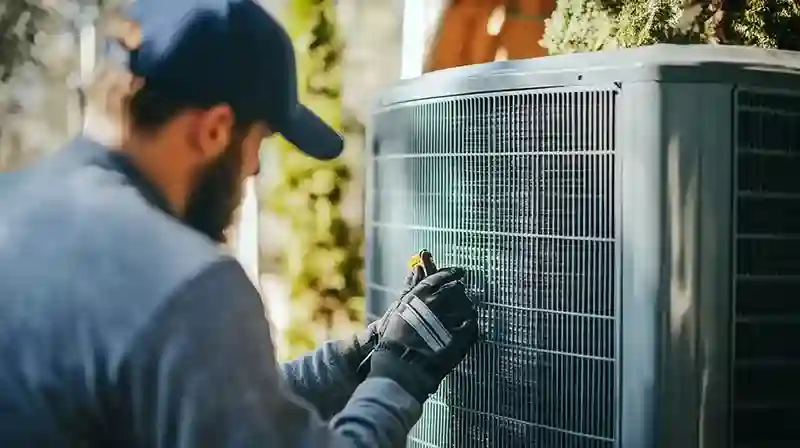
Kansas City homeowners often encounter many myths about their HVAC system. Believing these myths can lead to inefficiencies, higher costs, and even damage to your system.
Let’s debunk some of these HVAC system myths and set the record straight.
- Myth: Closing vents in unused rooms saves energy.
- Fact: This might seem logical, but closing vents can actually make your HVAC system less efficient. HVAC systems are designed to balance airflow, and closing vents disrupt this balance. It can increase pressure in the ductwork, causing leaks and reducing the system’s efficiency. According to Energy Star, keeping vents open helps maintain proper airflow and efficiency. Instead of closing vents, consider zoning systems that allow for more precise temperature control without disrupting airflow.
- Myth: Maintenance is not necessary if the system is working fine.
- Fact: Regular maintenance is crucial for keeping your system running efficiently and preventing breakdowns. Even if your HVAC system seems to be working fine, routine inspections and maintenance can catch minor issues before they become major problems. The U.S. Department of Energy recommends annual maintenance to ensure optimal performance and extend the lifespan of your system. Scheduling annual tune-ups can improve energy efficiency by up to 15%, according to the Indoor Air Quality Association.
- Myth: A bigger AC is better.
- Fact: An oversized air conditioner can lead to short cycling, where the system turns on and off frequently. This not only wastes energy but also fails to dehumidify your home properly, making it feel less comfortable. The key is to size your AC correctly based on your home’s square footage and insulation. The Air Conditioning Contractors of America (ACCA) provides guidelines for proper sizing and installation. A properly sized unit runs more efficiently and lasts longer.
- Myth: You only need to change the filter once a year.
- Fact: HVAC system filters should be changed every 1-3 months, depending on usage and the type of filter. Dirty filters restrict airflow, making your system work harder and reducing its efficiency. Regular filter changes can improve air quality and extend the life of your system. According to the Department of Energy, regularly changing filters can reduce energy consumption by 5-15%. Using high-efficiency particulate air (HEPA) filters can further enhance indoor air quality.
- Myth: Setting the thermostat higher or lower will heat or cool your home faster.
- Fact: Thermostats control the target temperature, not the speed at which your home reaches that temperature. Setting it too high or too low will not speed up the process but can lead to energy waste and discomfort. Smart thermostats can help manage your home’s temperature more efficiently by learning your schedule and adjusting accordingly. Using a smart thermostat can save up to $180 annually, as noted by Nest.
- Myth: Ceiling fans cool the room.
- Fact: Ceiling fans don’t actually lower the room’s temperature; they create a wind-chill effect that makes you feel cooler. This means you can set your thermostat a few degrees higher in the summer and still feel comfortable. The U.S. Department of Energy states that using ceiling fans can help save on cooling costs, but remember to turn them off when you leave the room. Proper ceiling fan usage can save up to 4-8% on cooling costs.
Tips for Choosing the Right HVAC System
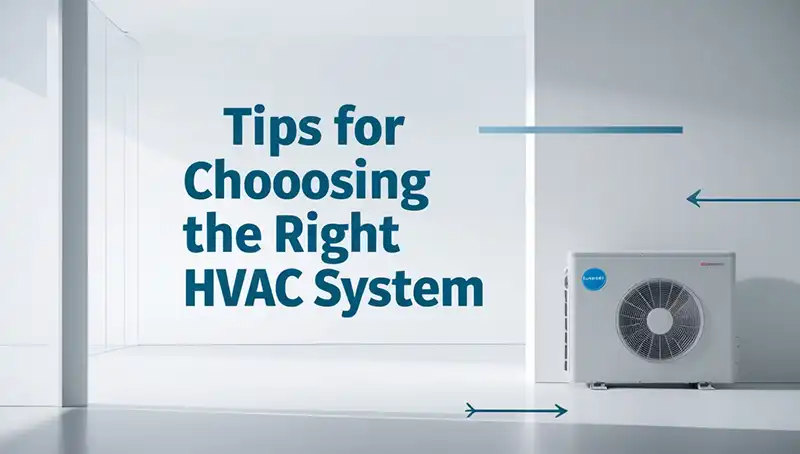
Choosing the right HVAC system for your Kansas City home involves considering various factors, from the local climate to your specific needs and budget. Here are some tips to help you make an informed decision:
Consider the Climate:
Kansas City Climate: Kansas City experiences hot, humid summers and cold, snowy winters. This means you’ll need a system that can handle both extremes effectively. Heat pumps can be a good choice for milder temperatures, but you might need a furnace or boiler for the colder months. According to the National Weather Service, Kansas City averages 24 inches of snow per year, emphasizing the need for reliable heating.
Check Your Home Size and Layout:
Size Matters: The size of your HVAC system should match your home’s square footage and layout. An oversized or undersized system can lead to inefficiency, increased wear and tear, and higher energy bills. Use tools like the Air Conditioning Contractors of America’s Manual J to perform a load calculation and determine the right size for your system.
Check Energy Efficiency Ratings:
Efficiency Ratings: Look for systems with high SEER (Seasonal Energy Efficiency Ratio) ratings for cooling and high AFUE (Annual Fuel Utilization Efficiency) ratings for heating. Higher ratings mean better efficiency and lower energy bills. For example, a system with a SEER rating of 16 or higher is considered efficient. The Energy Information Administration notes that upgrading to a high-efficiency HVAC system can reduce energy consumption by 20-50%.
Know Your Budget:
Initial Cost vs. Long-Term Savings: While high-efficiency systems may have a higher upfront cost, they often lead to significant long-term savings on energy bills. Factor in installation costs, potential rebates, and long-term operational costs. According to HomeAdvisor, the average cost to install a new HVAC system in Kansas City ranges from $5,000 to $12,000, depending on the system and home size.
Financing Options: Many HVAC companies offer financing options to spread the cost over time. Look for low-interest financing or deferred payment plans to make the investment more manageable.
Look for Rebates and Incentives:
Local and Federal Programs: Take advantage of rebates and incentives offered by local utilities and the federal government. Evergy provides rebates for energy-efficient HVAC systems. Additionally, federal tax credits for energy efficiency can further reduce the cost. Visit the Energy Star website for more information on available incentives.
State Incentives: Missouri offers various incentives for energy-efficient home improvements. Visit the Database of State Incentives for Renewables & Efficiency (DSIRE) to find out more.
Know the System Features:
Smart Technology Integration: Consider systems that offer smart technology integration, such as smart thermostats and zoning capabilities. These features enhance comfort and efficiency by allowing you to control the system remotely and tailor settings to your schedule. According to Nest, smart thermostats can save Kansas City homeowners up to 12% on heating and 15% on cooling costs.
Noise Levels: Check the noise levels of different systems. Quieter systems can improve indoor comfort, especially if the HVAC unit is located near living or sleeping areas.
Look for Reliable Brands and Warranties:
Brand Reputation: Choose a reliable brand known for quality and durability. Research customer reviews and ask for recommendations from trusted HVAC professionals. Brands like Trane, Carrier, and Lennox are well-regarded for their performance and reliability.
Warranties: Ensure the system comes with a comprehensive warranty that covers parts and labor. A good warranty can provide peace of mind and protect your investment. Most reputable brands offer warranties ranging from 5 to 10 years.
Conclusion
As a Kansas City homeowner, investing in and maintaining the right HVAC system regularly is crucial for enhancing your home’s comfort, efficiency, and overall value. The tips and insights provided throughout this article are designed to help you make informed decisions about your HVAC system needs.
- Choosing the Right System: Selecting the appropriate HVAC system for your home is vital. Consider the size of your home, the local climate, energy efficiency, and your budget. Remember, a properly sized and efficient system will save you money in the long run on energy bills and reduce the need for frequent repairs.
- Importance of Regular Maintenance: Regular maintenance is not just a recommendation; it’s a necessity. It ensures that your system operates at peak efficiency, extends its lifespan, and helps you avoid costly breakdowns. As noted by the U.S. Department of Energy, regular maintenance can enhance system efficiency and greatly improve your home’s heating and cooling performance.
- Energy Efficiency: Embracing energy-efficient systems and practices not only lowers your utility bills but also contributes to a healthier environment by reducing your carbon footprint. With the increasing focus on sustainability, taking steps to enhance energy efficiency in your home is more important than ever.
- Smart Technology: Integrating smart technology, such as smart thermostats and HVAC system monitoring, can further optimize your home’s heating and cooling. These technologies offer convenience and control, allowing you to adjust settings remotely and receive alerts about necessary maintenance or inefficiencies.
- Utilize Available Resources: Take advantage of local rebates, federal tax credits, and incentives that can help offset the cost of upgrading to more efficient systems. These financial incentives not only help you save money upfront but also promote long-term savings through reduced energy consumption. Check with Evergy for local rebates and visit the Energy Star website for federal tax credits.
- Professional Guidance: Finally, don’t underestimate the value of professional advice and installation. Working with qualified HVAC system professionals ensures that your system is installed and maintained correctly, which is key to its performance and durability. According to Angi, professional installation can improve efficiency by up to 30%.
Actionable Steps for Kansas City Homeowners
- Schedule Regular Maintenance: Book bi-annual check-ups with a trusted HVAC system professional.
- Upgrade to Smart Technology: Consider installing a smart thermostat to optimize energy use.
- Apply for Rebates and Incentives: Research local and federal programs to save on installation costs.
- Educate Yourself on System Options: Understand the benefits of different HVAC systems to make better choices when the time comes.
- Seal and Insulate Your Home: Improve your home’s insulation to maximize your HVAC system efficiency.
Following these guidelines will help you enjoy a comfortable home environment all through the year.
Frequently Asked Questions
The best type of HVAC system for energy efficiency depends on your specific needs and home setup. Generally, heat pumps are highly efficient for both heating and cooling.
According to the U.S. Department of Energy, heat pumps can reduce electricity use for heating by approximately 50% compared to electric resistance heating. For extreme cold conditions, a high-efficiency furnace combined with a smart thermostat can also provide significant energy savings.
Additionally, geothermal heat pumps offer superior efficiency by utilizing the consistent temperature of the ground.
It’s recommended to have your HVAC system serviced twice a year—once in the spring before the cooling season and once in the fall before the heating season.
Regular maintenance ensures your system runs efficiently and helps prevent costly breakdowns.
The Indoor Air Quality Association states that regular maintenance can enhance system efficiency by up to 15%.
During these visits, a technician will check critical components, clean the system, and make necessary adjustments to keep it running smoothly.
Most modern thermostats, especially smart thermostats, will automatically switch to emergency heat if the primary heating system cannot keep up with the demand.
It’s essential to ensure your thermostat is correctly programmed and compatible with your HVAC system.
According to Nest, their smart thermostats handle such automatic adjustments seamlessly, ensuring your home stays comfortable without manual intervention.
Always check your thermostat settings and consult the user manual for optimal performance.
Ice on a heat pump during winter is not unusual, but it should defrost automatically. If ice persists, it could indicate a problem with the defrost cycle.
First, check if the defrost mode is working. If not, clear any debris around the unit and ensure the coils are clean.
If the problem continues, it’s best to call a professional.
According to Energy Star, regular maintenance can help prevent such issues.
If you notice continuous ice buildup, it could be a sign of low refrigerant, a faulty defrost sensor, or a malfunctioning reversing valve.
The primary difference is environmental impact. Older Freon (R-22) is being phased out due to its ozone-depleting properties.
The newer refrigerant (R-410A) is more environmentally friendly and does not deplete the ozone layer.
If your system uses R-22, you may want to consider upgrading to a newer model that uses R-410A.
The Environmental Protection Agency (EPA) provides guidelines on the transition from R-22 to R-410A.
Upgrading to a system using R-410A can also improve efficiency and performance, as R-410A operates at higher pressures and absorbs and releases heat more efficiently than R-22.
The reversing valve in a heat pump allows the system to switch between heating and cooling modes by reversing the flow of refrigerant.
It is typically located near the compressor. This component is crucial because it enables the heat pump to provide both heating and cooling efficiently.
If the reversing valve malfunctions, your heat pump might not switch modes properly, necessitating professional repair.
According to HVAC.com, a functioning reversing valve is essential for optimal heat pump performance.
If you suspect a problem with the reversing valve, look for signs like reduced heating or cooling performance and unusual noises from the heat pump.
Have Any Questions?
If you have more questions about your HVAC system or need personalized advice, feel free to reach out to us.


